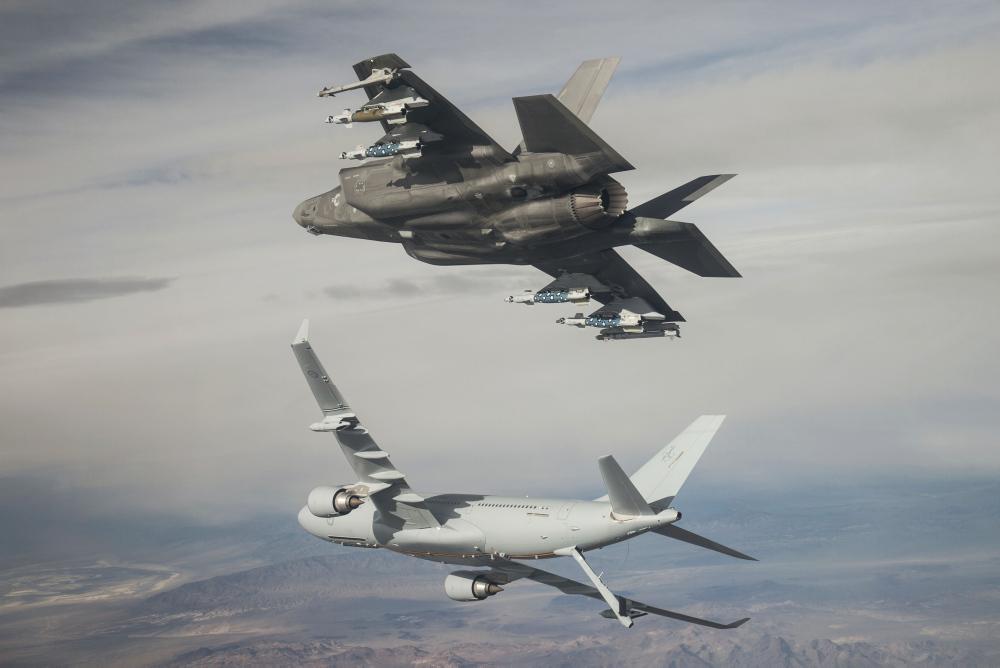Contested skies: our uncertain air superiority future
Posted By Peter Layton on January 30, 2018 @ 06:00

In war, there’s a constant to and fro. At times defence dominates, at other times offence. Technologies arise and fall. Disruption rules. This is noticeably so in today’s arcane world of air superiority. While much investment has gone into the ADF’s air superiority capabilities—with more coming with the F-35 Joint Strike Fighter—the operational environment isn’t standing still.
The skies are increasingly contested. Emerging threats are making our tanker and AEW&C (airborne early warning and control) aircraft more vulnerable [1], and advanced surface-to-air missiles [2], stealth-fighter technology, long-range ballistic [3]and cruise missiles and even hobbyist drones [4] are proliferating. The US Air Force (USAF) recently studied [5]what all this means in practice and determined that its ‘projected force structure in 2030 is not capable of fighting and winning against [the expected] array of potential adversary capabilities’. If the USAF’s force structure is becoming stretched so, surely, is ours.
Some warn [6] that the 2030 date may mislead, asserting that ‘Integrated Air Defence Systems covering areas in the Western Pacific … may now be able to deny access to all but the stealthiest of aircraft’. The ‘stealthiest of aircraft’ refers to the flying wing B-2 Spirit stealth bombers and forthcoming B-21 Raiders. It seems that F-35s with their vertical tails have some vulnerabilities [7] to emerging multiband digital radars. A RAND study [8] echoes these concerns about current and growing air-superiority shortcomings.
Even so, 2030 isn’t far away in defence terms. It’s only seven years after Australia’s F-35 fleet will have—hopefully [9]—reached final (or full) operational status. That’s not long in the planned 25- to 30-year life of the aircraft.
Australia has committed to its major air superiority investments, which makes them a good starting point to discuss the strategic impacts of known and emerging changes in the air superiority operational environment. In my new paper published by ASPI titled Contested skies [10], I use current air superiority force structure plans to develop three practical strategic options to address these changes.
Two of these options require modifying the current plans. That may worry some, but strategic ‘ends’ can’t be determined independently of the capability ‘means’. The two are interdependent. When the means are fixed, it makes sense to discuss alternative ‘ways’ that might reasonably bring strategic ends into alignment.
The three options are:
- Continuing with our current plans. Maintaining our current operational plans and future equipment programs means lowering our national ambitions to simply the defence of the Australia. This ‘back to the future’ approach implies abandoning Southeast Asian nations to do the best they can as China rises and its sphere of influence expands. Strategically, this shifts the burden of conducting offensive air operations onto our American ally. While we could contribute by providing a safe base area [11] in any conflict in which the skies were seriously contested, this level of involvement wouldn’t give us much influence on overall allied strategy or in any war-termination negotiations. Our current air superiority plans doom us to being a bit player.
- Going ‘air defence heavy’. This option changes our current capability development plans to stress air defence. A start would include acquiring significant numbers of advanced surface-to air missiles and sensors for integrated air and missile defence, changing our F-35 upgrade plans and focusing on making airbases more resilient. Strategically, the ‘air defence heavy’ approach would allow Australia to remain deeply engaged in Southeast Asia and make a meaningful—perhaps decisive—contribution in times of serious conflict. Because this approach is less reliant on US support, it would allow us to mount independent operations in an area critical to our future. This has some echoes with the Pacific War’s later stages, when the US relied on Australian forces to conduct operations in Borneo while it focused on the Philippines and beyond.
- Rebuilding our strike capability. This option entails adjusting our current plans to focus on reconfiguring our strike capability to be effective in contested airspace beyond 2030. We’d also need to make a limited investment in integrated air and missile defence. The USAF study mentioned earlier foresees the F-35 losing its strike role at the end of the next decade and then becoming an air defence fighter—taking the ‘strike’ out of ‘Joint Strike Fighter’. This applies to all of the elements that comprise the ADF’s strike capabilities, not just to the F-35. If we want to maintain a genuine strike capability into the future, we need to take positive steps to do so. But this won’t be easy or low cost—or maybe even doable.
In broad terms, the status quo ‘defence of Australia’ option implies burden-shifting onto the US, the ‘air defence heavy’ approach implies a reduced dependency on the US—perhaps lessening America’s burdens—while the rebuilding of our strike capability implies continuing to share the burden with the US in major ‘must-win’ wars past 2030.
Air superiority may seem narrowly technical, but it can have a significant impact on the range of strategies that can realistically be considered. It’s time for a big air-superiority rethink.
Article printed from The Strategist: https://aspistrategist.ru
URL to article: /contested-skies-uncertain-air-superiority-future/
URLs in this post:
[1] tanker and AEW&C (airborne early warning and control) aircraft more vulnerable: https://www.youtube.com/watch?v=OE-INNj_XbU
[2] advanced surface-to-air missiles: http://www.airforcemag.com/MagazineArchive/Pages/2017/April%202017/Saving-Air-Superiority.aspx
[3] ballistic : https://fas.org/irp/threat/missile/bm-2017.pdf
[4] hobbyist drones: http://centralblue.williamsfoundation.org.au/other-peoples-air-power-islamic-states-unmanned-air-force-peter-layton/
[5] studied : http://www.af.mil/Portals/1/documents/airpower/Air%20Superiority%202030%20Flight%20Plan.pdf
[6] Some warn: http://csbaonline.org/research/publications/force-planning-for-the-era-of-great-power-competition/publication
[7] some vulnerabilities: http://docs.wixstatic.com/ugd/a2dd91_cd5494417b644d1fa7d7aacb9295324d.pdf
[8] RAND study: http://www.rand.org/pubs/research_briefs/RB9858z3.html
[9] hopefully: https://breakingdefense.com/2018/01/f-35-problems-late-iote-f-35a-gun-inaccurate-f-35b-tires-threat-data-cyber/
[10] my new paper published by ASPI titled Contested skies: https://www.aspistrategist.ru/report/contested-skies-our-uncertain-air-superiority-future
[11] providing a safe base area: http://sdsc.bellschool.anu.edu.au/experts-publications/publications/5683/sovereign-defence-industry-capabilities-independent
Click here to print.